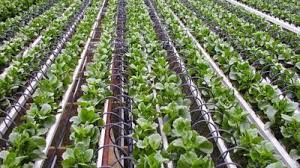Global hydroponics market size was valued at USD 2.1 billion in 2020. It is expected to expand at a compound annual growth rate (CAGR) of 20.7% from 2021 to 2028
The hydroponics market was worth USD 9.5 billion in 2020, with a CAGR of 11.3 percent expected to reach USD 17.9 billion by 2026. The pressure on the agriculture industry to meet rising demand for grains and food has led to the development of high-yielding farming techniques such as precision farming and urban farming. As a result, hydroponics is being considered as a possible answer to the rising worry about food security in the next years.
Impact of COVID-19 on the Global Hydroponics Market
Many people have formed a negative attitude about outside food as a result of the Covid-19 outbreak. With health and food safety taking centre stage, people all around the world are gravitating toward home cooking and self-made/homemade meals. The food and lodging industries have been put in peril as a result of this. Following the horrific emergence of the coronavirus pandemic, the adoption rate of urban hydroponic farming systems is expected to skyrocket over the world. During the early stages of the pandemic, the agriculture industry encountered difficulties. On the farm, there were severe labour shortages, some farmers missed their harvesting window for seasonal crops, agricultural product prices were plummeting, and logistics were disrupted. Many countries also realised that they were overly reliant on food imports and began focusing on domestic and internal production.

Market Trends
Driver: Higher production when compared to traditional farming methods, which was highlighted especially more after the Covid-19 pandemic.
Plants produced in hydroponic systems have attained a 20 percent–25 percent higher yield than traditional agriculture systems, with productivity being 2–5 times higher, according to UN reports on global population. Furthermore, the influence of climatic variations can be balanced with the help of these systems due to controlled environmental conditions, resulting in no impact on annual crop yield. CEH techniques have a direct impact on agricultural harvesting. Because weather variations have a minor impact on such systems, crops can be grown all year, hence increasing output.
High capital investment for large-scale farms is a constraint.
A hydroponic farm’s main cost factors include HVAC systems, fans, ventilation, irrigation systems, control systems, railways, and lighting, among others. For a basic system that is not fully automated, a 500 sq. ft. hydroponic farm can cost up to USD 110,000. The high initial cost of setting up the system is a big deterrent to farmers investing in these systems. However, these methods provide larger yields, and the food can also be marketed as premium products, increasing the return on investment for producers.
Development of revolutionary hydroponic technology is an opportunity.
Manufacturers and academics are attempting to improve the efficiency of hydroponics technology to raise the quality and quantity of product as the technique becomes more widely adopted. Many companies in the market are extensively investing in R&D in order to gain cutting-edge technology that will increase production while also allowing for a wider diversity of cultivations. The expansion of the hydroponics market is aided by strategic alliances with research labs and institutes.
In closed systems, the spread of waterborne illnesses and algae is a problem.
The potential of watery pathogens poses a big problem for producers in a closed hydroponic system. Because the nutrient-enriched water is recirculated throughout the system, any waterborne disease that enters the nutrient reservoir has the potential to propagate throughout the system, affecting the entire crop. Plants are frequently spaced apart by growers to avoid crowding, which is a common way for infections to infiltrate the system. Growers are adopting screen or paper filters, as well as other filtration systems, to limit the spread of waterborne infections in their systems.
The liquid sub-segment is expected to have the biggest market share in this market’s by type segment.
In the hydroponics business, liquid systems have proven to be efficient and cost-effective when compared to simple models. The initial cost of setting up hydroponic systems is excessive, which is also one of the industry’s key bottlenecks. The economics of liquid systems, on the other hand, appear to be possible, as all liquid systems function in a closed mode, lowering the cost of nutrient solution. Furthermore, when compared to the closed model of aggregate systems, liquid systems offer superior productivity, and as a result, the majority of producers have installed liquid systems for crop production.
The HVAC system is expected to have the greatest market share in the global hydroponics market by equipment.
HVAC, or heating, ventilation, and air conditioning, plays an important part in the growth of indoor growers since it is responsible for cooling, dehumidification, and maintaining the ideal temperature inside the facility. Hydroponic and aeroponic farms require reliable and well-controlled HVAC systems. Furthermore, because to the system’s lower cost compared to other hydroponics equipment and utilities, the HVAC is expected to see an increase in demand.
In the by input section of this market, the nutrients sub-segment is expected to develop at the quickest rate throughout the projected period.
Hydroponic-based crops require a lot of external nutrients because they don’t grow on soil. Most crops are now grown directly in the nutrient medium, thanks to the increased use of soilless growing techniques in hydroponics. As a result, the demand for nutrients in this industry rises.
The fruits sub-segment is expected to develop at the quickest CAGR in this market until 2025, according to crop type.
Because of the inside conditions of the greenhouse or indoor farming unit, fruits cultivated under hydroponics can be grown and harvested all year. Farmers choose water-adaptable fruits like watermelon, cantaloupe, and tomatoes because they are easier to cultivate using hydroponic methods. The hydroponics market is expected to increase quicker as more varieties of fruits are brought under cultivation.
